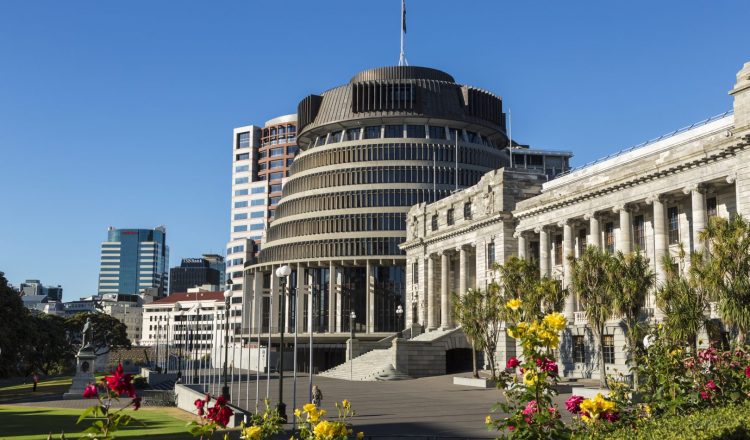뉴질랜드 정치제도
뉴질랜드의 정치는 단일 국회 대표 민주주의의 틀 안에서 작동합니다. 뉴질랜드는 입헌군주제로 1952년 2월 6일부터 엘리자베스 2세 여왕이 통치자이자 국가 원수입니다.
뉴질랜드 국회는 입법권을 가지고 있으며 여왕과 하원으로 구성되어 있습니다. 여왕을 대신해 뉴질랜드 총독로 참석합니다. 의원들은 보통 3년마다 선출됩니다. 뉴질랜드의 많은 입법 관행은 영국 웨스트민스터 의회가 정한 불문율 및 판례에서 비롯됩니다. 소수당은 일반적이며 보통 다른 정당과의 신뢰 및 동의에 의존합니다. 뉴질랜드의 주요 정당은 역사적으로 노동당(현 정권 여당)과 국민당(전 정권 여당)이었지만, 다당제를 채택하고 있습니다.
뉴질랜드의 국가 권력은 “여왕이 통치하지만 정부가 지배하는 것”이라는 원칙에 근거합니다. 빼놓을 수 없는 과정이긴 하지만, 여왕과 총독은 정치적으로 중립적이며 통치의 일상적인 측면에 관여하지 않습니다.장관은 민주적으로 선출된 국회의원 중에서 선출됩니다. 대부분의 장관은 뉴질랜드 정부의 주요 의사 결정 기관인 내각의 구성원입니다. 총리는 최고위 장관, 내각의장, 정부 수반입니다. 다른 장관은 총리의 조언에 따라 총리가 임명하고 의회에 모두 책임이 있습니다.
Economist Intelligence Unit(경제정보연구소)은 2016년 뉴질랜드를 “완전한 민주주의” 국가로 평가했습니다. 정부의 투명성으로 높은 순위를 차지하며 세계에서 부패 수준이 가장 낮습니다.
MMP
MMP(Mixed Member Proportional, 비례대표)는 현재 뉴질랜드에서 시행되고 있는 투표 제도입니다. 정당은 의회에서 가능한 한 많은 좌석을 얻고 싶어합니다. 따라서 사람들이 투표할 때, 자신이 거주하는 지역을 대표하고 싶은 사람을 선택합니다. 가장 많은 표를 얻은 후보가 승리하여 MP가 됩니다.
여러 정부 기관
입법부
국회는 법안을 통과시키고, 주예산을 채택하고, 행정 정부를 통제할 책임을 집니다. 현재 하원이라는 단일한 의회가 있습니다. 1951년 이전에는 제 2의 의회인 입법위원회가 있었습니다. 하원은 웰링턴의 국회의사당에서 열립니다.
국회의사당은 하원의 본거지로서 번안이 처음으로 발의하는 곳입니다. 그들은 의회법(즉, 법정법)이 되기 전에 의원과 총독의 승인 과정을 거쳐야 합니다.
국회의원은 MPs(Members of Parliament)으로 불리며, 예외적인 상황에서는 선거가 더 일찍 실시될 수 있지만, 최고 임기는 3년입니다. 1893년 이후 참정권은 투표권은 만18세 이상의 영주권자 이상의 시민들이라면 거의 갖습니다. 수많은 국회 제도에서와 마찬가지로 행정부(이하 “정부”라 함)는 의회에서 선출되며 의회에 답변해야 합니다. 예를 들어, 불신임 동의안이 통과되면 정부는 사임하거나 의회 해산 및 조기 총선을 치뤄야 합니다.
행정부
엘리자베스 2세 여왕은 뉴질랜드의 군주이자 국가 원수입니다. 여왕은 보통 뉴질랜드에 거주하지 않기 때문에, 군주제의 기능은 여왕의 대리인인 총독이 수행합니다. 2016년 이후, 현재 총독은 Dame Patsy Reddy입니다. 총독은 공식적으로 장관을 임명 및 해임하고 국회를 해산할 수 있는 권한을 가지며, 하원을 통과한 후 왕실 동의에 의해 법안을 거부하거나 법안으로 서명할 수 있는 권한을 가집니다. 집행위원회의 의장은 모든 장관으로 구성된 공식 위원회로, 총독에게 특권 행사에 대해 조언합니다. 집행 위원회 구성원은 의회(MP)의 구성원이어야 하며, 대부분이 내각에 속해 있습니다.
내각은 총리가 이끄는 가장 고위 정책 결정 기구이며, 총리는 관례상 제1여당 대표이기도 합니다. 뉴질랜드의 실질적 지도자인 총리는 공식적으로 군주에 부여된 행정 기능을 (특권의 행태로) 행사합니다. 내각 장관들은 종합적으로 모여 중대한 결정을 내립니다. 따라서 이러한 결정의 결과에 대해 연대 책임을 집니다.
총선이 끝나면, 정부는 다수 의원의 신임(지지)을 지휘할 수 있는 정당이나 연합에 의해 구성됩니다. 가장 최근에 치러진 2017년 9월 총선은 노동당이 2위를 차지했지만 NZ Fisrt당과의 연정과 녹색당과의 신뢰와 합의를 통해 집권할 수 있었습니다. Jacinda Ardern 총리가 이끄는 제6차 노동당 정부는 2017년 10월 26일 총독에 의해 출범했습니다.
2017년부터 국민당은 노동당 주도의 정부에 대한 공식 반대파를 구성해 왔습니다. 야당 지도자는 총리가 이끄는 내각의 행동을 면밀히 조사하는 그림자 내각의 수장을 맡고 있습니다. 의회 내의 야당은 정부가 책임을 지도록 돕습니다.
사법부
뉴질랜드 사법부에는 네 가지 기본 수준의 법원이 있습니다.
- 대법원
- 상고법원
- 고등법원
- 지방법원(청소년 법원 포함)
대법원은 대법원법(2003년)에 따라 2004년에 설립되었으며, 런던의 추밀원을 대체하여 뉴질랜드의 최고 재판소가 되었습니다. 고등법원은 심각한 범죄와 민사 문제를 다루며 하위법원의 항소를 심리합니다. 상고법원은 고등법원으로부터 법적인 사항에 대한 항소를 심리합니다.
대법원장, 사법부 수장이 대법원을 주재하고, 국무총리의 조언에 따라 총독부가 임명합니다. 2019년 현재 대법원장은 Dame Helen Winkelmann입니다. 다른 모든 상급 법원 판사는 대법원장, 법무장관 및 법무장관 등의 조언에 따라 임명됩니다. 법관과 사법관은 행정정부로부터 사법의 독립성을 유지하기 위해 비정치적이고 엄격한 임기 규정에 따라 임명됩니다. 심사위원은 자격, 개인적 자질 및 관련 경험에 따라 임명됩니다. 판사는 입증된 위법 행위에 대해 하원의 연설에 따라 법무장관이 아니면 해임될 수 없습니다.
뉴질랜드 법률에는 세 가지 주요 출처가 있습니다. 영국 관습법, 1947년 이전에 제정된 영국 의회의 특정 법령(특히 권리장전 1689), 뉴질랜드 의회의 법령입니다. 법원은 관습법을 해석함에 있어 영국 및 관련 관할 지역에서 해석된 관습법과 일관성을 유지하기 위해 노력해 왔습니다.
국회의사당(의원)
국회의원 또는 MP는 일반적으로 총선에서 의회에 선출된 사람들입니다.
MP는 다양한 역할을 가지고 있습니다. 일부 의원은 정부, 정당, 직권당에 적을 두고 있으며, 일부 의원은 그 반대입니다. 모든 의원은 하원에서 뉴질랜드 국민의 대표입니다. 또한 일반적으로 정당을 대표합니다.그들의 의무는 다음과 같습니다.
- 뉴질랜드 국민의 견해와 관심을 대표
- 새로운 법률 제정 및 개정
- 세금 지출 방식 승인
- 정부가 현명하고 책임있는 결정을 내리는지 확인

















































